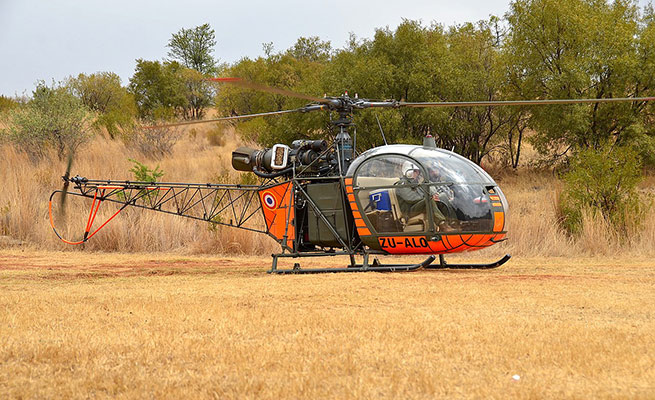Aérospatiale Alouette II – French helicopter

The Aérospatiale Alouette II is a French light helicopter originally manufactured by Sud Aviation and later Aérospatiale. It was the first production helicopter powered by a gas turbine engine instead of the heavier conventional piston powerplant.
On 12 March 1955, the prototype SE 3130 performed its maiden flight. It was a widely used type and popular with operators, with over 1 300 rotorcraft eventually being constructed between 1956 and 1975. The type was predominantly used for military purposes in observation, photography, air-sea rescue, liaison and training, but it has also carried anti-tank missiles and homing torpedoes. As a civilian helicopter, the Alouette II has been used for casualty evacuation (with two external stretcher panniers), crop-spraying and as a flying crane, with a 500-kilogram external underslung load.
A high-altitude derivative, the SA 315B Lama, was developed and entered operational service in July 1971. The Alouette II also was further developed into the larger and more powerful Alouette III. In 1975, production of the type was terminated, having been effectively succeeded by these newer rotorcraft. Despite it being long out of production, considerable numbers of Alouette II were still in service at the start of the 21st century.
History
The Aérospatiale Alouette II is a light single engine helicopter that was awarded a French domestic certificate of airworthiness which cleared the Alouette II for civil operators. On the 14th January 1958… the FAA granted certification to the Alouette II. Hence it became the first turbine powered helicopter to certified in the USA. The Alouette II SE 3130 later became known as the Alouette II SA 313B.
Design
In addition to being a light helicopter the Alouette II also has a reasonable lift capacity on an external sling. Powered by a single Turbomeca Artouste II C5 or C6 engine. The three blade main rotor is high mounted to the rear of the cockpit. It features a single turbo shaft engine with an upturned exhaust. Furthermore it is high-mounted on the fuselage to the rear of the cockpit and also the main rotor shaft. The bubble cockpit is oval and transparent offering excellent visibility. It has fixed skid landing gear. The tail boom is an open framework with the tail being small and rectangular. Moreover it has square-tipped flats forward of a small, right side-mounted rotor. The helicopter is capable of accommodating up to five personnel, including the pilot. Access to the cabin is via a pair of side-hinged doors.
Alouette II SA 313B – 1963
Rhodesia emerged as a prolific user of not only the Alouette II but also the Alouette III. Operations flown by the Army and SAP, included paramilitary and aerial reconnaissance. Subsequently the type spread into further roles throughout its service. These included not only aerial supply but also HEMS, communication relays.. and troop transports. Over 50 countries have used the Alouette II in military service. As a civilian helicopter, its uses include EMS and also crop spraying.
Variants
SE 3130 Alouette II – After 1967 called SA 313B Alouette II.
SE 3131 Gouverneur – Refined executive version with enclosed tail boom,which was abandoned in favour of the Alouette III.
SE 3140 Alouette II – Proposed version, it was going to be powered by a 298 kW (400 hp) Turbomeca Turmo II engine. None were built.
HKP 2 Alouette II – Swedish licence version of the SE 3130
SA 318C Alouette II Astazou – It has a 550 shp (410 kW) Turboméca Astazou IIA shaft turbine (derated to 360 shp) and strengthened transmission system of the Alouette III.
SA 318C Alouette II (was SE 3180 Alouette II) – After 1967 it was called the SE 3150.
SA 315B Lama – designed to meet an Indian armed forces requirement for operation in “hot and high” conditions; it combined the Artouste powerplant and rotor system of the Alouette III with a reinforced Alouette II airframe.
Even before flight testing had been completed, the Alouette II was showing its abilities as a mountain rescue aircraft. The second prototype Alouette II was in the Alps for performance tests in July 1956 when the test team learned that a climber was dying after having a heart attack in the Vallot Mountain refuge, one of the highest in Europe at 4 362m.
The first attempt at a rescue was unsuccessful, but the second worked: within five minutes of landing the helicopter had transported the climber to hospital in Chamonix, thereby saving his life.
At the beginning of 1957 two Alouettes carried out a similar rescue, retrieving six mountain guides, and two pilots of an S-55 rescue helicopter which had crashed, from the same refuge.
Since then the Alouette II and its high-altitude version, the Lama, have carried out many mountain rescues, retrieving stranded climbers from places that would not have been reachable by any other means.
The Alouette’s successor, the Aerospatiale Ecureuil, is now serving with the Nepalese Army. The type has already retrieved climbers from high on Everest.




